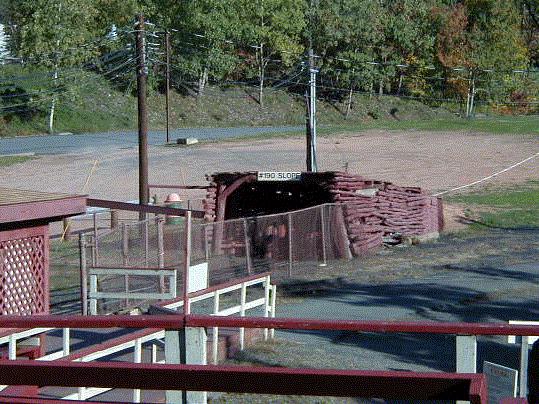 |
The ride is surprisingly smooth, except for some bumps and starts near
the slope bottom, where the track curves towards the bottom landing.
Over the portal, the sign says "#190 Slope", the original name of the
mine entry.
|
In mid-October of 1999, we took a short holiday in eastern Pennsylvania,
making day-trips from lodgings in Clark Summit on the northwestern outskirts
of Scranton. Our first stop was the Anthracite Heritage complex in Scranton,
consisting of the Lackawanna Coal Mine and the Anthracite Heritage Museum.
The coal mine affords an underground tour of mine-workings, guided by an
experienced mine-worker. We had the great luxury of taking the tour twice
in one day: the first time with a retired coal miner, and the second time
with a mining engineer. Our two guides offered markedly different perspectives
on what it meant to work in a coal mine, and gave us the benefit of their
two opinions on matters such as working conditions, workplace health and
safety, and the benefits of mechanisation. Between our two excursions down
the hole, we visited the adjoining museum (admission to one site affords
a pass to the other) and learned about the social context and community
heritage of the mining communities in and around Scranton. We also were
privileged to have a visit with the mine foreman, Lee Ruch, in the hoist-room
of the mine; it is not often that one gets to see the inner workings of
mine hoists, which have their own peculiar mysteries.
Visitors wait for the mantrip in a screened porch. Once the mantrip
is loaded, it travels down to track into the portal and proceeds about
400 metres down the mine's slope.
 |
The ride is surprisingly smooth, except for some bumps and starts near
the slope bottom, where the track curves towards the bottom landing.
Over the portal, the sign says "#190 Slope", the original name of the
mine entry.
|
The trip down the mine takes about two minutes. Everyone rides together in a bright yellow (and very clean) mantrip car, which runs on a well-laid rail track. The mantrip is lowered into the mine by a steel wire rope, which is spooled in and out from an electrically-powered hoist. Safety cables ensure that the mantrip cannot run away out of control in the unlikely event of a break in the hoisting rope.
The landing at the bottom of the slope is well-lit, surprisingly roomy,
and securely supported by closely-spaced sets of steel I-beams.
| The mantrip car has comfortable bench seats which can hold four across; its windows are screened with wire mesh as a safety measure, and it has its own headlights. |
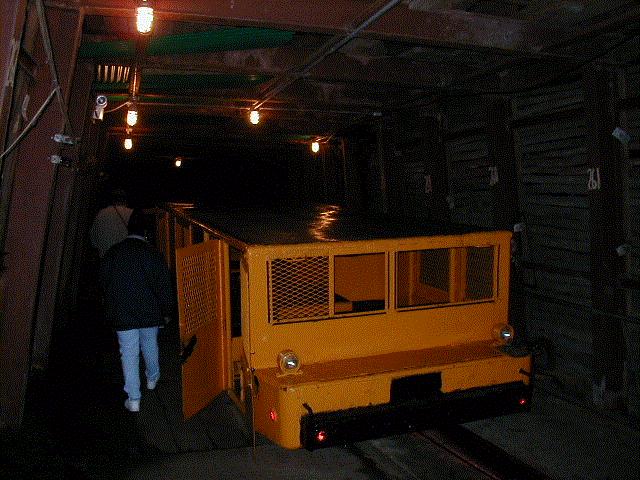 |
Once the mantrip has arrived at the bottom of the slope, everyone alights onto the mine floor. All of the workings have some sort of flooring, be it crushed stone, concrete or closely-set boards. Although a working coal mine would have less-palatial walking surfaces, the smooth floors of the Lackawanna Mine allow for the possibility of wheelchair access, and certainly make for a more enjoyable stroll through the belly of the earth.
The workings at the slope bottom are 3.6 to 4.4 metres high, which to a collier from Britain or Vancouver Island would be sheer luxury. Roof support appears to be substantially overbuilt as compared with the apparent solidity of the mine's roof and walls. Considering that virtually none of the mine's visitors have any prior experience in underground mining, this is a prudent approach to safety.
One thing that is most surprising is the lack of roof-bolts within the mine. Our guides explained that roof-bolting was not permitted in Pennsylvania's anthracite mines, so timber and steel support is necessary. Here and there we find some small bolts set into the roof, acting simply to support wires, cables and pipes which must be suspended up out of harm's way. The roof itself is most often a hard sandy siltstone, sandstone or grit, quite a bit coarser that what one usually sees in a coal mine.
Railway tracks run throughout the accessible workings of the mine; most
of these tracks are now only used to haul materials for repair or reconstruction
of the mine, since it is no longer actively being worked. The mantrip cannot
travel further into the mine beyond the slope-bottom landing, since it
has no power source of its own, and it depends on the hoist at the top
of the slope for its motive power. A stout buffer prevents runaways at
the bottom of the landing.
The working-places are capacious, perhaps too capacious for comfort.
Piles of siltstone or sandstone 'gob' are left where they fell from the
roof. Walkways are cleared alongside the rooms; lines of timber props support
the cap-rock above the walkways.
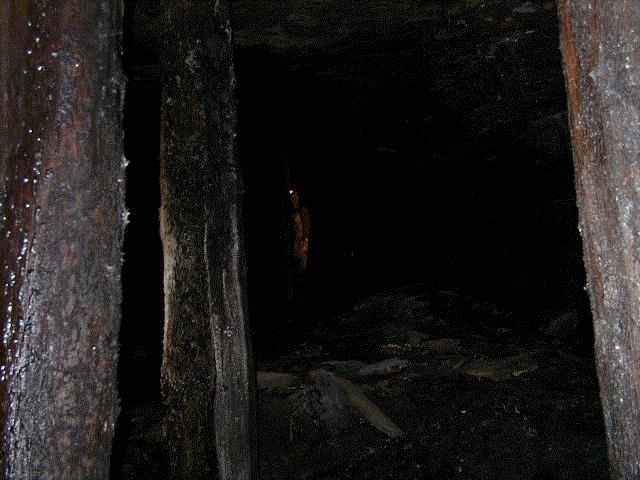 |
As we look up into the chamber, a mannequin clad in oilskins provides us with a sense of the great size of this room; it looks to be about 3.5 metres high and 6 or 7 metres wide. |
In most places, very little timber has been used to support the mine's
roof. The timbers look to be from 20 to 40 cm in diameter. The dip up from
the level doesn't look to be all that steep, but looking down on the other
side affords a more vertiginous view.
| The timbers on the lower side of the main level look to be in better shape; perhaps they have been more recently installed. They are held in place against the roof by wooden wedges. The hard coal stands well alongside this room, with little sign of crumbling. |
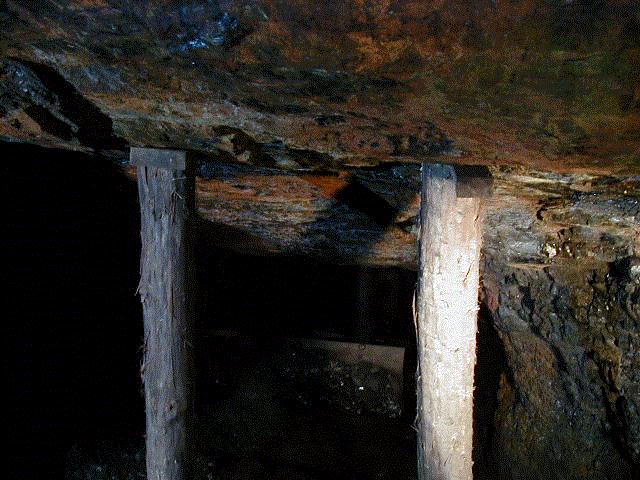 |
A series of 'batteries', wide wooden boards, are installed between the posts that support the rooms. These boards prevent loose coal from sliding away in an uncontrolled manner.
The main level continues southward along the hillside. Heavy posts,
bars and lagging support the roof. The posts are set an an angle across
the pitch of the coal bed; this helps secure them in place against the
possibility of a creep in the mine's roof. A barricade across the level
clearly indicates the point beyond which we may not go. The level is lit
by a few light bulbs, but it eventually curves away out of sight, leading
the wistful geologist to wonder what lies beyond the corner.
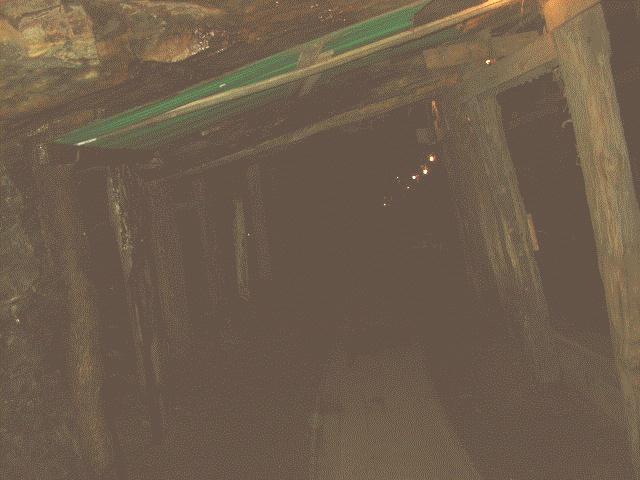 |
Fiberglass sheeting is used to redirect a watercourse away from the
heads of unwary visitors.
A string of lights leads into the further recesses of the mine. The main level gradually turns a corner as it follows a local cross-fold in the coal bed. Its end is lost to view. |
At the barricade, a display of machinery and equipment has been set up. Our attention is drawn to a stout metal tool-box, which looks to be so heavy that it could not possibly 'walk away' by accident or design. Some miner's tools are arrayed on the box's lid.
The oddly-shaped wrenches are perhaps meant for adjusting specific pieces
of machinery, whose internal clearances are so tight that a straight wrench
could not be used. As with everything else in this mine, these tools are
robustly made.
| Most of the tools look like they have lain here since the dawn of time. A patina of rust and stone-dust makes them blend in with the lid of the tool box. |
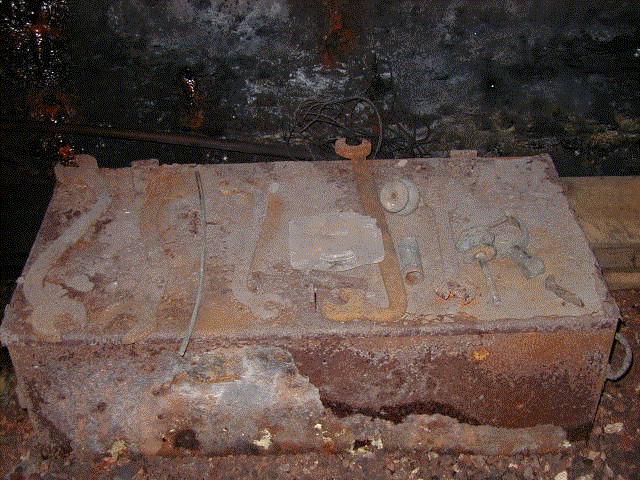 |
Some of the side-workings approach the main level so closely that the intervening pillars of coal are very narrow. Supplementary roof support in these areas is provided by stone-filled timber cribs or 'cogs'.
Cogs are much stronger than individual timber props, or even three-piece
sets of props and crossbars. They take much longer to build, and are usually
made by a team of two or three miners working together.
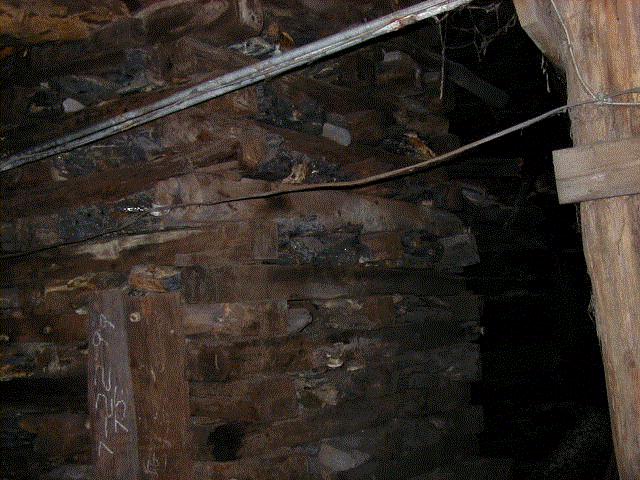 |
The chalked numbers are a note from the mine's fireboss, indicating the most recent date on which this part of the mine was inspected. |
Most of the weight-bearing capacity of a cog is provided by its rock
fill. Usually this rock consists of material which has been barred loose
from the mine's roof, but sometimes rock from partings within the coal
bed is used, if these partings exist and consist of sufficiently-hard rock.
The timber cribbing acts mainly to confine the rock fill, and takes a lesser
proportion of the weight. Looking up the side of a cog, it is evident that
the rock fill has been closely packed between the timbers.
| This cog is built in crossed layers, three sticks per layer. Just enough
room has been left to step alongside and inspect its side nearest the coal
pillar.
The cog is about 1.8 metres square and 4 metres high. It probably took at least a day for its building. |
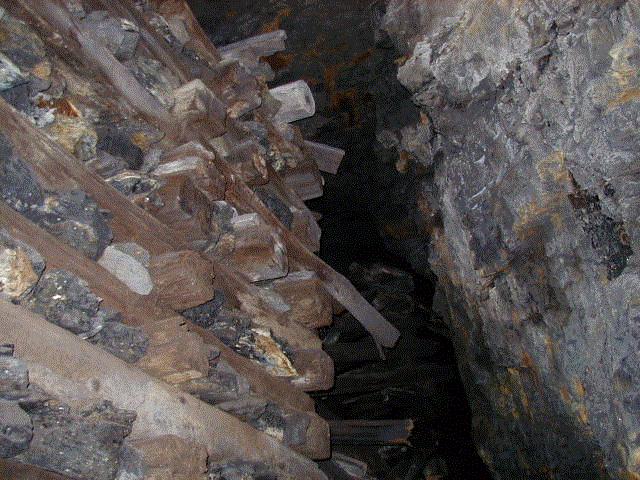 |
During our tour, we pay a lot of attention to the mine's roof and its means of support. A well-maintained mine will have good roof support, and few broken or rotten timbers will be allowed to stay unrepaired for long. The one exception to this rule is in those parts of the mine which are being actively encouraged to cave, either in the course of depillaring, or to relieve pressure on more-important roadways whose long-term stability must be assured.
Having a strong coal bed helps, obviously. The anthracite in the Lackawanna
Mine is mostly hard and strong, and its well-banded appearance shows up
nicely as we inspect the pillars along the main level. This hard anthracite
must be drilled and blasted in order to break it up into pieces that the
miner can load. Knowing exactly where and how to drill the coal, and what
amount of explosive to use, is where the miner's art comes into play.
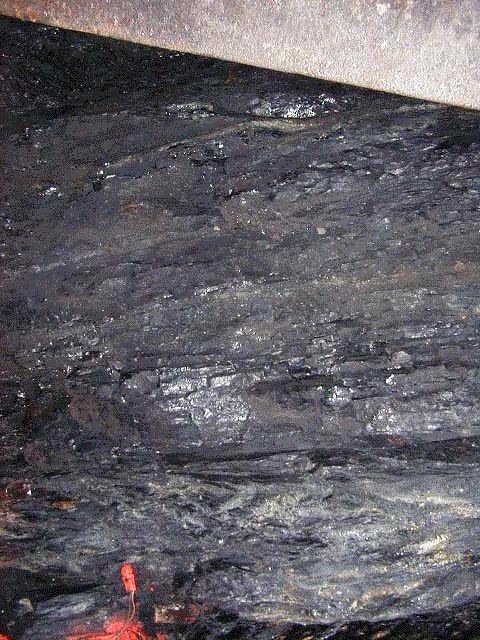 |
Looking at the side of a pillar, with a wooden crossbar above us, we
see banded anthracite.
Banding in this coal probably indicates alternation of bright, clean layers with dull, dirtier layers. Nevertheless, this is a pretty fine sight to behold. The field of view here is about 1.5 metres. |
Sometimes the structure of a coal bed becomes more complex. Local 'rolls'
or small folds are apparent in parts of the coal. These probably represent
structures formed while the coal's precursory peat was still soft and plastic,
and it could flow under pressure. Perhaps a channel-fill of gravelly sand
further above the recently-buried peat increased the loading on the peat,
and it flowed in response. Also possibly is that a channel-scour removed
some of the overlying sediment, locally reducing the pressure on the peat,
which would then flow towards the area of reduced loading.
| We are looking up alongside the pillar's edge, into a roll within an
overhanging part of the coal bed.
The geologist's trusty walking-stick serves as a convenient scale, indicating that our field of view is about 1.8 metres high. |
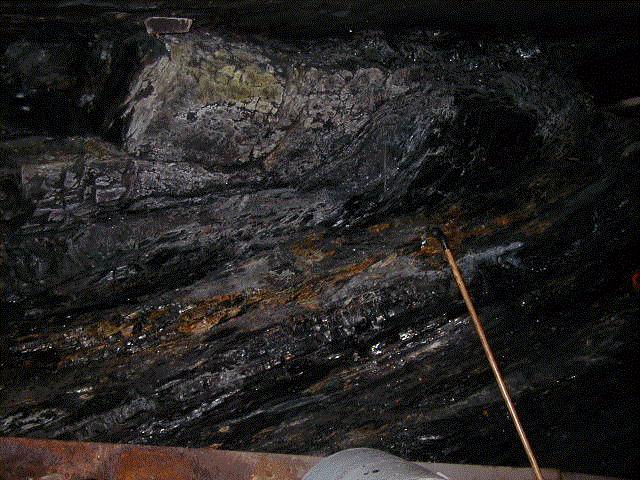 |
Understandably, miners usually prefer to work the thicker coal beds
first, but late in the life of a colliery their attentions are inevitably
drawn to thinner beds that they passed by in earlier workings.
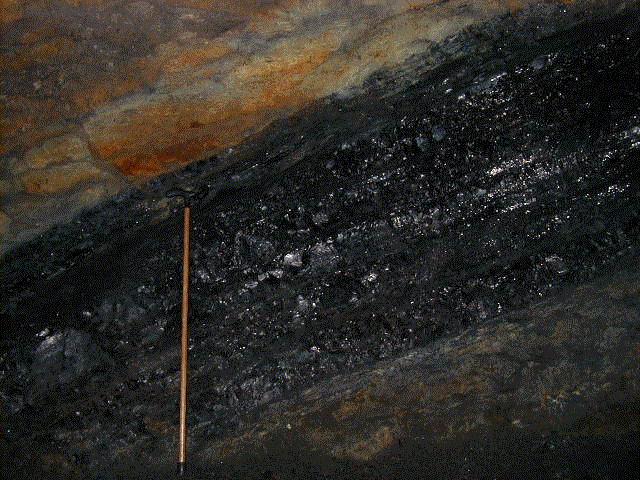 |
Even a thin coal such as this one, might be workable if it was sufficiently
clean and it had a decent roof and floor.
This coal is about 75 cm thick. It looks to be quite bright and clean. |
When a coal bed is cut by a cross-measures tunnel such as the one we are touring, it can usually be opened by level workings in both directions from the tunnel. Sometimes the miners will make a side landing on the coal, and then drive up and down along the full dip of the coal, to open up a broader area of workings. This might be done if rapid expansion of the mine's productive capacity was desired, but more often the new coal bed will first be 'proven' by following it in either direction with a pair of levels.
As a mine is further developed, a veritable maze of workings is excavated. Directional signs become increasingly important, especially if the workers must evacuate the mine by means of escapeways which lead through unfamiliar areas. The Lackawanna Mine is well-marked with such signs, and even if an accident befell the tour guide, visitors would be able to find their way out with little difficulty.
A 'second opening' to the mine is required by law. If something happens
to the main exit, this escapeway affords a second chance for the workers.
| The sign-board's message is clear enough, even if the miners cannot read English. An arrow indicates the best way to travel. The reflective signboard increases its chance of being read when smoke or dust fills the workings. |
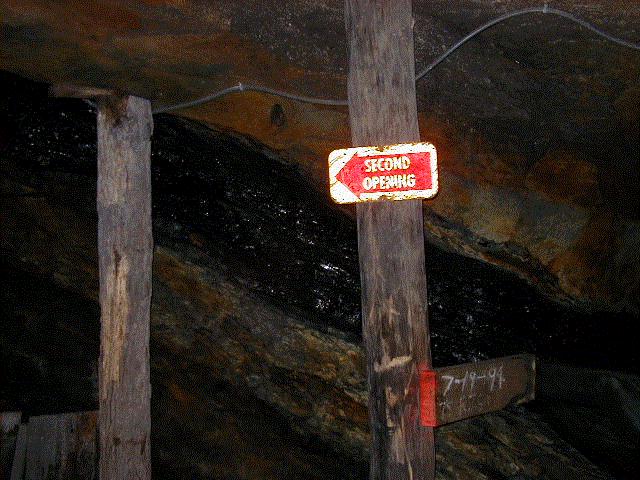 |
At the far end of the tunnel, a thicker coal bed is reached. This coal was entered late in the mine's life, and only a limited amount of work was done on it. Level roadways and rooms extending up-dip provide several working-faces in the coal. In this part of the mine, the dip was too low to allow the coal to slide unaided along chutes, so shaker-conveyors were used to get the coal down from the faces to the loading-points on the level. Shakers were most productive when the coal was being conveyed along level or descending workings, but they could throw the coal up-dip with reduced efficiency.
Shakers consist of a series of sheet-steel troughs or 'pans', which
may be supported on flexible trestles or hung by chains attached to the
mine's timbers.
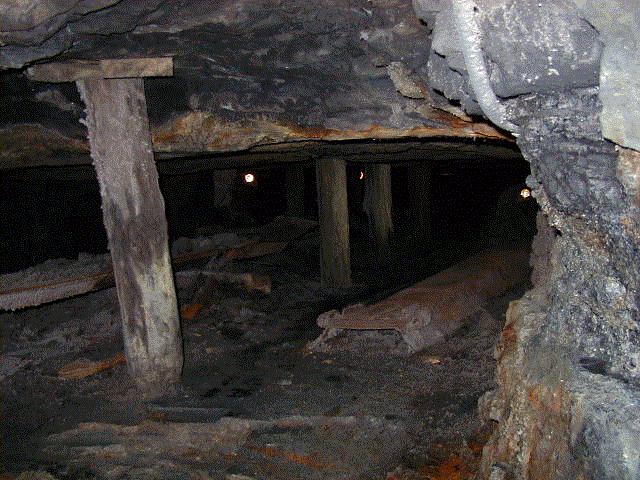 |
An extra piece of troughing lies upside-down along the right side of
the room.
This coal bed has only a fair roof, and thus warrants more closely-spaced timbering. Some parts of the roof have scaled and slabbed away between timbers in the foreground. |
Shaker-conveyors worked by making a jerky, cyclical oscillation back and forth along the pan-line, causing the coal to bounce and slide along the pans. They were powered by compressed-air or electric motors, which made for efficient working. Still, they were generally so noisy that the miners were unable to hear the sounds of the mine's roof cracking or 'working', which increased the likelihood of being caught under a roof fall.
The discharge-end of a shaker was usually cribbed up on blocks, providing
sufficient clearance to run a mine-car in underneath the conveyor to receive
the coal.
| What's missing from the drive unit?
The drive unit has recently enjoyed a fresh coat of paint, but it lacks a drive belt. Perhaps the rats ate it? |
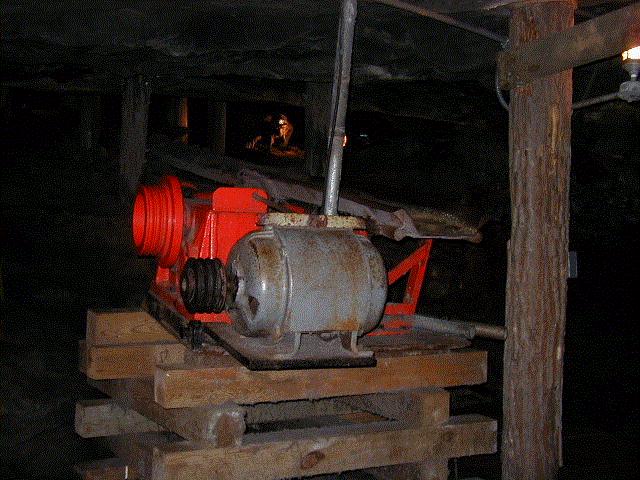 |
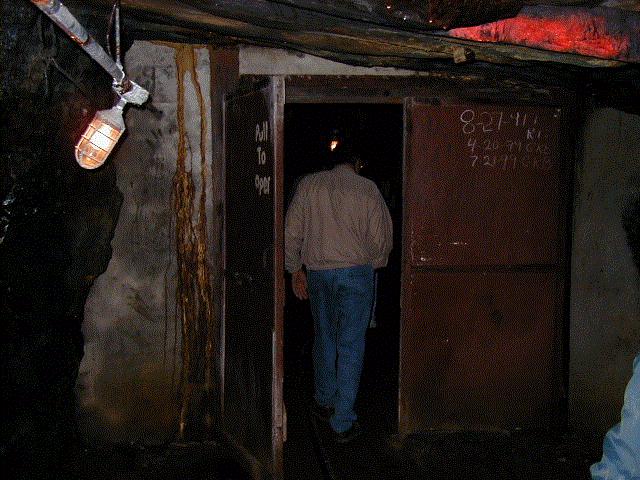 |
The notice on the airlock says "pull to open". Airlocks are made to
close in the direction of air movement, so that they are less likely to
be inadvertently left open.
The fireboss has chalked the dates of inspection on the other door. |
Where it is not necessary to pass through between two sides of a ventilation
circuit, concrete-block stoppings are used to seal roadways. Concrete blocks
are laid in mortar, and at least one face of the stopping (the high-pressure
side) is usually plastered-over to reduce air leakage.
| Although these stoppings are intended to be permanent, they are can be blown out by blast waves in the event of an explosion. This yielding feature reduces the distance that blast waves will travel through the workings. |
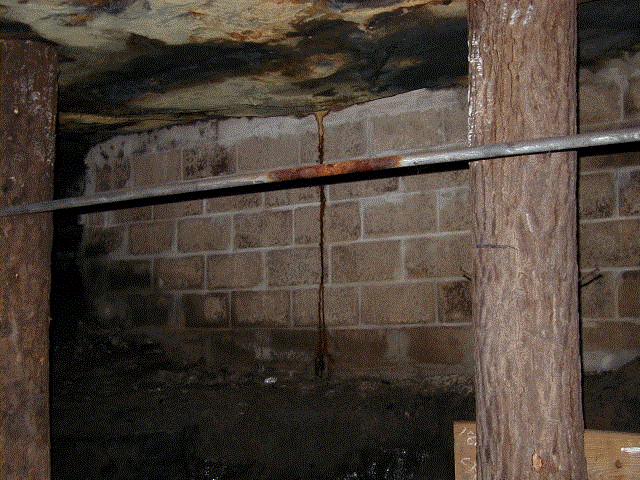 |
We retrace our steps along the tunnel until we come again to the landing
at the bottom of the Continental #190 Slope. We board the mantrip car,
and ride up the slope. Most of the slope is supported by closely-spaced
steel sets. Each set is numbered, for convenience in reporting the need
for repairs, or the location of service equipment.
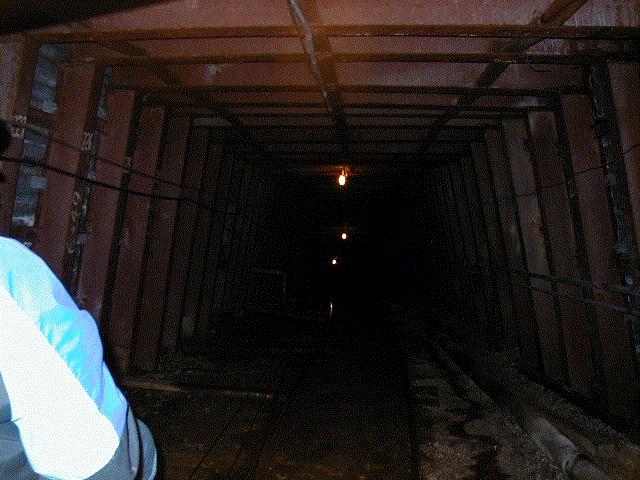 |
As we look through the front window of the mantrip we count down the
numbers.
The widely-spaced lamps atop the sets indicate that we are about to follow the slope up around a curve to the left. |
As we ride the mantrip up the slope, the car's wheels squeal loudly
while we round a curve in the slope. Although it's a noisy and bumpy ride,
we are definitely on our way home. Near the portal, the slope is supported
by segmental steel arches and corrugated-metal sheeting.
| Daylight shines along the rails, and shows the three cables which are being wound by the hoist. The taut cable is actually hoisting the mantrip, while the loose cables on either side are there for our safety; either one could arrest the mantrip if the main cable were to break. |
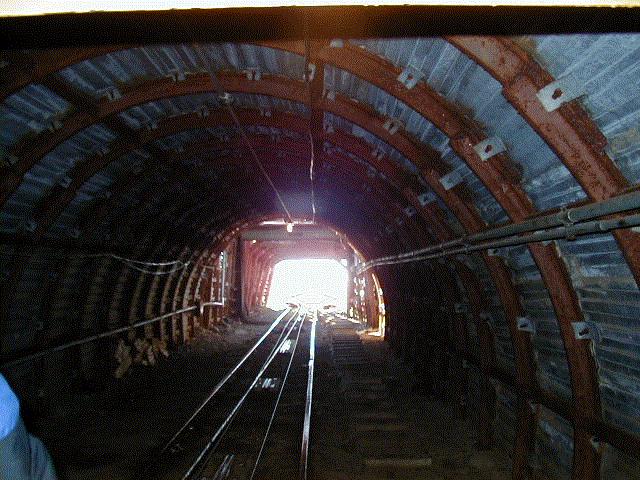 |
Finally at the surface, we return our windbreakers and hard-hats with
thanks. Our guide bids us farewell and goes into the hoistroom for a well-earned
break. He hangs his hard-hat up on the wall, and plugs his lamp into a
charger. Overnight charging brings the battery back up to full strength
for the following day's work.
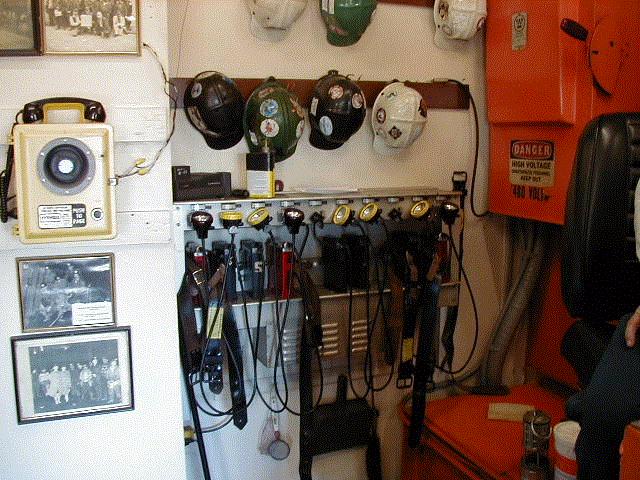 |
The headpieces of the miners' lamps provide their own connections to
the battery charger.
The framed photographs show the crew that rehabilitated the Continental #190 Slope to make the Lackawanna Mine Tour possible. |
A telephone links the hoist-room to the mine. The phone equipment is specially constructed to be flame-proof and explosion-proof. Mine rescue equipment is also kept here, just in case.
Using flash equipment, let alone using light-metal cameras containing batteries, is not normally safe practice in a coal mine. Always ask first before taking such equipment into a mine, and obey the instructions of the mine officials.
The mine is not suitable for children under the age of 6, owing to the extensive walking required. Good walking shoes or boots are recommended. Light refreshments and souvenirs are available at the mine. For more information, telephone the mine on (570) 963-6463 or (800) 238-7245.
Pennsylvania has several other heritage sites and museums that document
the history, social conditions, and technology of the anthracite industry.
Details are available via the Pennsylvania's
Anthracite Museums website.